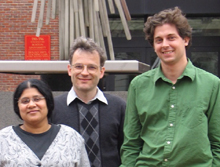 | Thursday, March 24, 2005 |
|
Thursday, March 24 2:00 p.m. Computing Techniques Seminar - FCC1 Speaker: F. Carminati, CERN Title: Alice Use of Grid Services - Status and Plans 2:30 p.m. Theoretical Physics Seminar - Curia II Speaker: O. Mena Requejo, Fermilab Title: Cosmic Neutrino Spectroscopy and the Early Universe 3:30 p.m. DIRECTOR'S COFFEE BREAK - 2nd Flr X-Over THERE WILL BE NO ACCELERATOR PHYSICS AND TECHNOLOGY SEMINAR TODAY
Friday, March 25 |
|
Extended Forecast |
Secon Level 3 |
|
Thursday, March 24 Southwestern Chicken Tortilla Soup Philly Style Cheese Steak $4.75 Baked Fish w. Roasted Leeks and Peppers $3.75 Tomato Basil Chicken Parmesan $3.75 Classic Cuban Panini $4.75 Four Cheese Pizza $2.75 Marinated Grilled Chicken Caesar Salads $4.75 The Wilson Hall Cafe now accepts Visa, Master Card, Discover and American Express at Cash Register #1.
Wilson Hall Cafe Menu |
| Fermilab Today is online at: http://www.fnal.gov/today/ Send comments and suggestions to today@fnal.gov Fermilab Today archive Fermilab Today PDF Version Fermilab Result of the Week archive Fermilab Safety Tip of the Week archive Linear Collider News archive Fermilab Today classifieds Subscribe/Unsubscribe to |
|
March 21 - March 23 - During this 48 hour period Operations established two stores that provided the experiments with approximately 38 hours and 15 minutes of luminosity - Store 4053 set record luminosity: 117.32E30 - Store 4053 lost due to separator spark - Booster has RF problems
Read the Current Accelerator Update |
|
From Mesabi Daily News, March 22, 2005 First neutrino recorded at Soudan test site by Charles Ramsay SOUDAN — The first neutrino has been captured here. William Miller, lab supervisor at the Soudan Underground Mine science project, said Tuesday he switched on his laptop computer at 7:30 a.m. Saturday to check the latest “bombardments’’ from the Fermilab’s MINOS neutrino particle accelerator toward Soudan. read more |
|
Topping the Top Mass | ||
| ||
Ten years ago, the CDF and DZero experiments discovered the top quark at
Fermilab. The Tevatron is still the only source of top quarks and we are now
measuring the properties of the top quark in detail. To test theoretical
predictions it is important to know the top quark mass precisely. For example,
the masses of the W boson, the top quark and the Higgs boson are related by
theory. If we measure the top quark and W boson masses we can predict the Higgs
This is not an easy measurement. The top quark is very short lived and decays into leptons (e.g. electrons or muons), neutrinos and other quarks, especially b-quarks. The quarks form jets of particles that cannot be measured individually. We have to relate the properties of the jets back to those of the original quarks. | ||
| ||
|
DZero has just completed two preliminary measurements of the top quark mass using data from Run II of the Tevatron. One analysis used events in which the top quark decay involved one lepton and (for the first time at DZero) asked for a b-quark to be identified in the events. The result is 170.6 +/- 7.3 GeV/c2 which is the most precise measurement of the top quark mass from Run II data to date. The other analysis uses top quark decays with two leptons. | ||
| ||
|
Result of the Week Archive |
|
Fermilab Children's Summer Day Camp Day Camp is offered in three, three-week sessions: Session I: June 13 - July 1, Session II: July 5- July 22, Session III: July 25 - August 12. The program is held in the lower level of the Kuhn Barn in the village from 7:30 AM - 5:30 PM. Admission is made through a lottery held on the last weekday in March. You can choose any or all of the sessions. The fee for each Day Camp session is $265.00 per camper. A $100.00 deposit per session per camper must accompany the registration form. Registrations will be accepted beginning March 1 until 5:00 PM on March 30. An information booklet and registration form can be found on the Recreation Website, Recreation Office, Users Office and the Housing Office.
|




